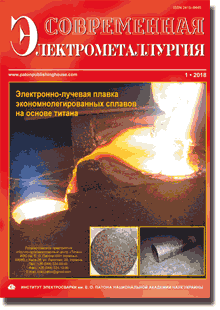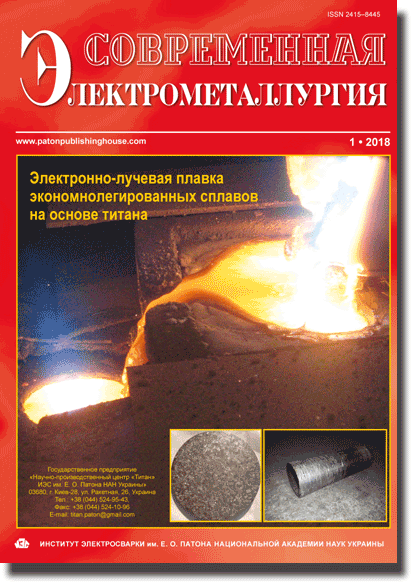
Electrometallurgy Today (Sovremennaya Elektrometallurgiya), 2018, #1, 3-8 pages
E.O. Paton Electric Welding Institute of the NAS of Ukraine 11 Kazimir Malevich Str., 03150, Kyiv, Ukraine. E-mail: office@paton.kiev.ua
Review is made about the tendencies of development of railway transport and changes, due to them, in service conditions and occurrence of defects, which decrease the rail service life. Growth in movement speed of passenger trains and increase in load to axle requires the improvement of rail quality and properties of steels from which they are manufactured. The increase in intensity of alternating contact loads, heating in long-time braking and corrosion factors cause the rails damage. Most of rail defects, leading to coming out of order, have the contact-fatigue origin and their formation is often connected with a metallurgical quality of steel, the improvement of which requires the technological updating of all the rail production cycle. Ref. 25, Fig. 1.
Key words: railway rails; movement speed; load to axle; service conditions; fatigue defects
Received: 14.02.18
Published: 20.03.18
References
AS = «Automatic Welding» - 6 issues per year;
TPWJ = «PATON WELDING JOURNAL» - 12 issues per year;
SEM = «Electrometallurgy Today» - 4 issues per year;
TDNK = «Technical Diagnostics and Non-Destructive Testing» - 4 issues per year.
| 2018 №01 (06) |
DOI of Article 10.15407/sem2018.01.01 |
2018 №01 (02) |

Electrometallurgy Today (Sovremennaya Elektrometallurgiya), 2018, #1, 3-8 pages
Modern rail steels and solutions ESR (Review). Information 1. Operating conditions and defects observed
L.B. Medovar, G.P. Stovpchenko, G.O. Polishko, E.A. Pedchenko, V.A. Zaitsev
E.O. Paton Electric Welding Institute of the NAS of Ukraine 11 Kazimir Malevich Str., 03150, Kyiv, Ukraine. E-mail: office@paton.kiev.ua
Review is made about the tendencies of development of railway transport and changes, due to them, in service conditions and occurrence of defects, which decrease the rail service life. Growth in movement speed of passenger trains and increase in load to axle requires the improvement of rail quality and properties of steels from which they are manufactured. The increase in intensity of alternating contact loads, heating in long-time braking and corrosion factors cause the rails damage. Most of rail defects, leading to coming out of order, have the contact-fatigue origin and their formation is often connected with a metallurgical quality of steel, the improvement of which requires the technological updating of all the rail production cycle. Ref. 25, Fig. 1.
Key words: railway rails; movement speed; load to axle; service conditions; fatigue defects
Received: 14.02.18
Published: 20.03.18
References
- (2017) The ten fastest trains in the world… 1801 to present. Smart train world. www.smartrailworld.com/the-fastest-train-in-the-world
- Soejima, H. (2003) Feature: Railway technical research in Asia railway technology in Japan – Challenges and Strategies. Japan Railway & Transport Review, 36, 4–13.
- https://en.wikipedia.org/wiki/TGV
- http://www.rzd.ru/static/public/ru?STRUCTURE_ID=666&layer_id=3290&id=35855-16
- (2017) Xinhua. http://news.xinhuanet.com/english/2017-09/21/c_136626345_2.html
- (2015) Japan train beated a proper record of speed. BBC Ukraine. http://www.bbc.com/ukrainian/science/2015/04/150421_maglev_speed_record_ko
- (2017) Hyperloop work begins before a business case is made. https://amp-ft-com.cdn.ampproject.org/c/s/amp.ft.com/content/64c31810-d375-11e7-ae3e-563c04c5339a
- Saeki, K., Iwano, K. (2013) Progress and prospects of rail for railroads. Nippon Steel & Sumitomo Metal. Technical Report, 105, 21–25.
- Tzanakakis, K. (2013) The railway track and its long term behaviour: A Handbook for a railway track of high quality. Springer Sci. & Business Media.
- Cannon, D.F., Edel, K.O., Grassie, S.L., Sawley, K. (2003) Rail defects: An overview. Fatigue & Fracture of Engineering Materials & Structures, 26(10), 865–886. https://doi.org/10.1046/j.1460-2695.2003.00693.x
- Kumar, S.A. (2006) A study of the rail degradation process to predict rail breaks. Lulea University of Technology, Division of Operation and Maintenance Engineering.
- Nikas, D., Ahlstrom, J., Malakizadi, A. (2016) Mechanical properties and fatigue behaviour of railway wheel steels as influenced by mechanical and thermal loadings. Wear, 366–367, 407–415. https://doi.org/10.1016/j.wear.2016.04.009
- (2005) Steels: Processing, structure, and performance. Сhapter 15. High-carbon steels: Fully pearlitic microstructures and applications. ASM International. https://www.asminternational.org/documents/10192/1849770/Chapter_15_WEB.pdf
- (2015) Technology for the future. UIC, The Worldwide Railway Organisation. https://uic.org/IMG/pdf/high_speed_brochure.pdf
- Girsch, G., Keichel, J., Gehrmann, R. et al. (2009) Advanced rail steels for heavy haul application-track performance and weldability. 9th International Heavy Haul Conference, 22–25 June 2009, Changhai, China, pp. 171–178.
- One step ahead. https://www.voestalpine.com/schienen/static/sites/schienen/.downloads/Image-Brochure.pdf
- Jiang, X., Li, X., Li, X. Cao, Sh. (2017) Rail fatigue crack propagation in high-speed wheel/rail rolling contact. of Modern Transportation, 25(3), 178–184. https://doi.org/10.1007/s40534-017-0138-6
- Olofsson, U., Lewis R. (2009) Tribology of the wheel-rail contact. Ed. by S. Iwnicki. A Handbook of Railway Vehicle Dynamics, Swets & Zeitlinger Publishers.
- Madler, K., Zoll, A., Heyder, R., Brehmer, M. (2008) Rail materials — alternatives and limits. http://www.researchgate.net/publication/267989542_Rail_Materials_Alternatives_and_Limits
- Marais, J.J., Mistry, K.C. (2003) Rail integrity management by means of ultrasonic testing. Fatigue & Fracture of Engineering Materials & Structures, 26(10), 931–938. https://doi.org/10.1046/j.1460-2695.2003.00668.x
- Smith, R. (2002) Rolling contact fatigue of rails: what remains to be done? http://www.railway-research.org/IMG/pdf/512/pdf
- Agarkov, O.V. (2013) Analysis of problems of defects formation in railway track rails. Visnyk Nats. Transport. Un-tu, 28, 3–8 [in Russian].
- Sawley, K., Reiff, R. (2000) Rail failure assessment for the office of the rail regulator. An assessment of Railtrack’s methods for managing broken and defective rails.
- Matvetsov, V., Miroshnikov, N., Kratenok, V. (2013) Damage of rails by defects in different service conditions. Visnyk TNTU, 71(3), 182–189 [in Russian].
- Rudyuk, A.S., Azarkevich, A.A., Voskovets, Yu.A. et al. (2011) Defectiveness of rails on railways of Ukraine. Put i Putevoe Khozyajstvo, 7, 28–32 [in Russian].
The cost of subscription/purchase order journals or individual articles
| Journal/Currency | Annual Set | 1 issue printed |
1 issue |
one article |
| AS/UAH | 1800 UAH | 300 UAH | 300 UAH | 150 UAH |
| AS/USD | 192 $ | 32 $ | 26 $ | 16 $ |
| AS/EUR | 180 € | 30 € | 25 € | 15 € |
| TPWJ/UAH | 7200 UAH | 600 UAH | 600 UAH | 280 UAH |
| TPWJ/USD | 384 $ | 32 $ | 26 $ | 16 $ |
| TPWJ/EUR | 360 € | 30 € | 25 € | 15 € |
| SEM/UAH | 1200 UAH | 300 UAH | 300 UAH | 150 UAH |
| SEM/USD | 128 $ | 32 $ | 26 $ | 16 $ |
| SEM/EUR | 120 € | 30 € | 25 € | 15 € |
| TDNK/UAH | 1200 UAH | 300 UAH | 300 UAH | 150 UAH |
| TDNK/USD | 128 $ | 32 $ | 26 $ | 16 $ |
| TDNK/EUR | 120 € | 30 € | 25 € | 15 € |
AS = «Automatic Welding» - 6 issues per year;
TPWJ = «PATON WELDING JOURNAL» - 12 issues per year;
SEM = «Electrometallurgy Today» - 4 issues per year;
TDNK = «Technical Diagnostics and Non-Destructive Testing» - 4 issues per year.





